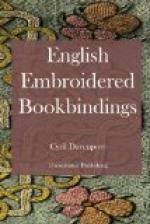Bible, etc. London, 1642.
The design on a Bible with Psalms, printed in London in 1642, bound in fine canvas, and measuring 6 by 3-1/2 inches, is the same on both sides. The ground is all laid, or couched, with silver threads, caught down at intervals by small white stitches. In the centre is a circular silver boss, and out of this grow four lilies worked with silver thread in button-hole stitch; each of these lilies has a shape similar to its own underneath it, outlined with fine gold cord, and filled in with red silk; representing altogether white flowers with a red lining. These four red and white lilies make together the form of a Maltese cross, and between each of the arms is a purl rose with yellow centre and graduated blue petals. A double oval, with the upper and lower curves larger than the side ones, marked with a thick gold cord, encloses the central cross, and the remaining spaces are filled with ovals and lines of gold guimp, with here and there a little patch of red or yellow purl, the extremities of the upper and lower ovals being filled with threads of green silk loosely bound with a silver spiral, worked to represent a green plot.
[Illustration: 13—Bible, etc. London, 1642.]
The upper and lower curves of the oval are thickened by an arch of gold thread laid lengthwise, and kept in place by little radiating lines of red silk. In each corner is a purl rose, with blue centre, the petals graduating in colour from pale yellow to dark red, with leaf forms and stalks of gold cord and guimp. At the top and bottom of the oval is a many-coloured purl rose, and the spaces still left vacant are dotted with little pieces of red, blue, and yellow purl and spangles. On the front edges are the remains of two red silk ties.
[Illustration: 14—Bible. London, 1648.]




